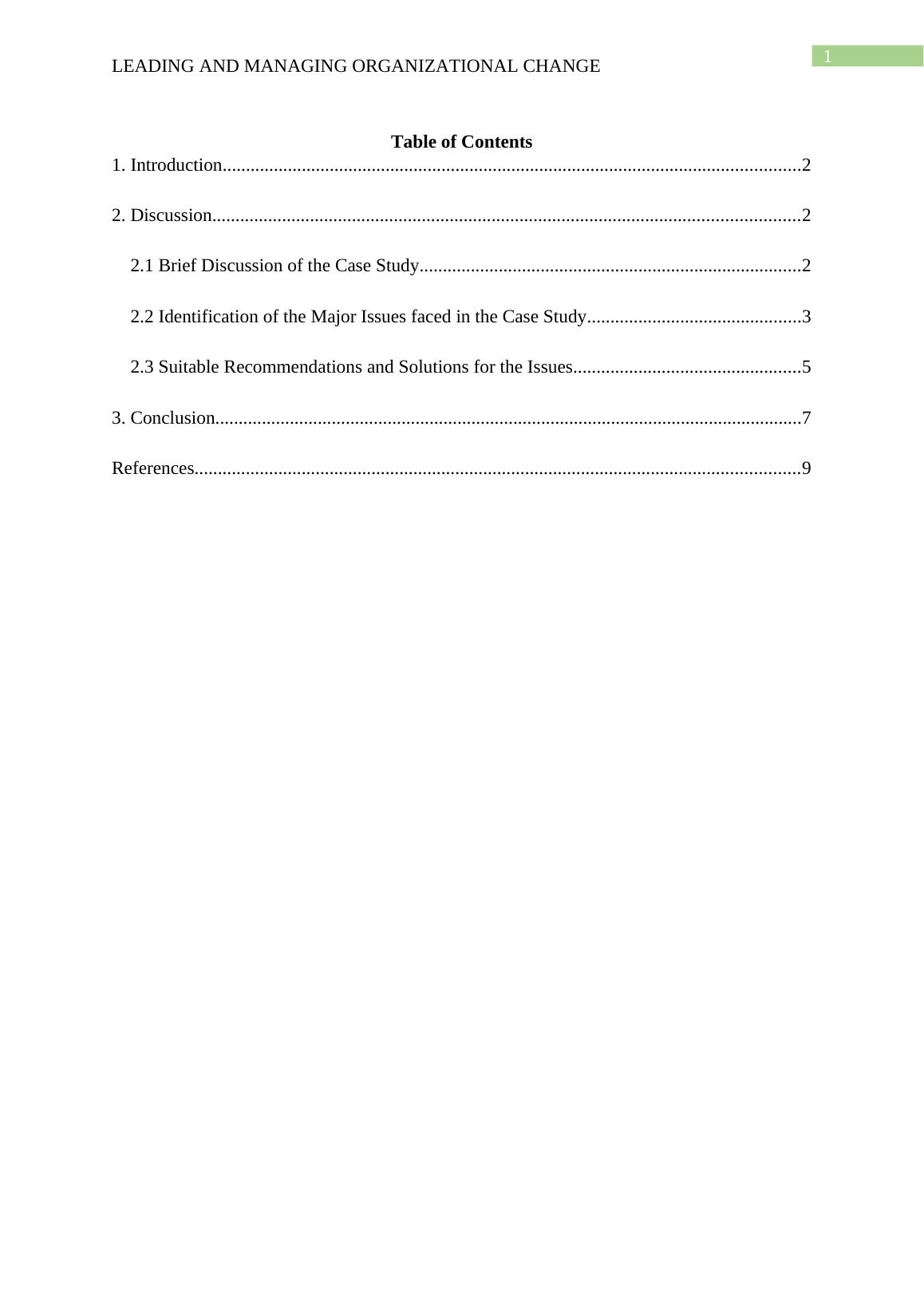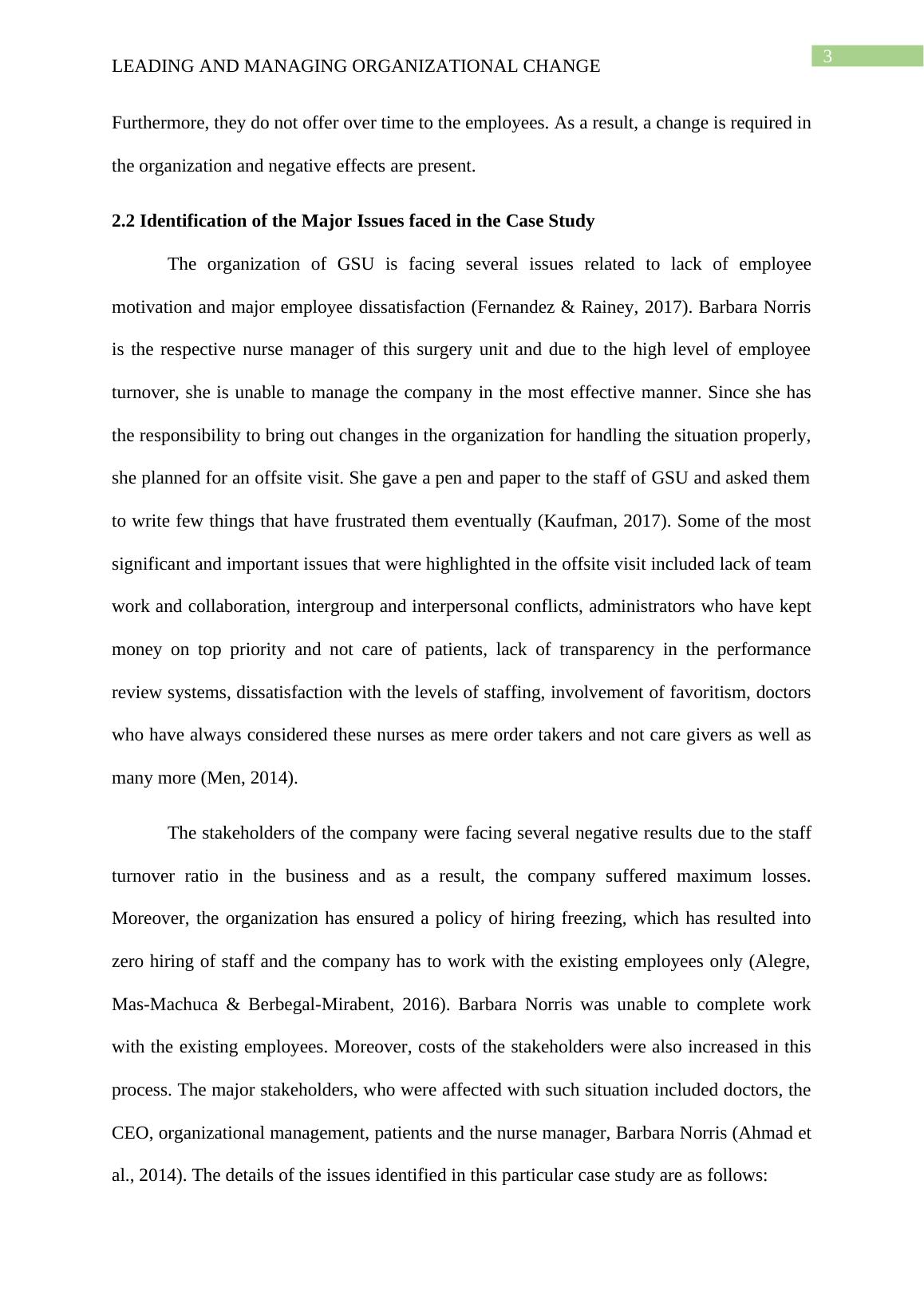Leading and Managing Organizational Change | Study
Added on 2022-08-31
11 Pages2913 Words20 Views
Running head: LEADING AND MANAGING ORGANIZATIONAL CHANGE
Leading and Managing Organizational Change
Name of the Student
Name of the University
Author’s Note:
Leading and Managing Organizational Change
Name of the Student
Name of the University
Author’s Note:

1
LEADING AND MANAGING ORGANIZATIONAL CHANGE
Table of Contents
1. Introduction............................................................................................................................2
2. Discussion..............................................................................................................................2
2.1 Brief Discussion of the Case Study..................................................................................2
2.2 Identification of the Major Issues faced in the Case Study..............................................3
2.3 Suitable Recommendations and Solutions for the Issues.................................................5
3. Conclusion..............................................................................................................................7
References..................................................................................................................................9
LEADING AND MANAGING ORGANIZATIONAL CHANGE
Table of Contents
1. Introduction............................................................................................................................2
2. Discussion..............................................................................................................................2
2.1 Brief Discussion of the Case Study..................................................................................2
2.2 Identification of the Major Issues faced in the Case Study..............................................3
2.3 Suitable Recommendations and Solutions for the Issues.................................................5
3. Conclusion..............................................................................................................................7
References..................................................................................................................................9

2
LEADING AND MANAGING ORGANIZATIONAL CHANGE
1. Introduction
Organizational change is regarding the procedure to change the organizational
strategies, procedures, culture and technologies for understanding the over5all impact of the
changes over the respective company (Benn, Edwards & Williams, 2014). Such distinct
changes could either be continuous or could even occur for certain time period. It refers to
any type of alteration, which takes place in the entire working environment. This type of
change is also referred to as the most significant feature of maximum companies and a proper
company should eventually develop the major adaptability to change periodically according
to the forces of change (Tidd & Bessant, 2018). It is inevitable in the most progressive culture
and the modernized organizations are extremely dynamic, adaptive and versatile to the
multiplicity of changes. The following report outlines the case study of Barbara Norris with
relevant details related to leading change in the general surgery unit. The issues faced by the
organization with suitable recommendations and solutions will also be provided in this report.
2. Discussion
2.1 Brief Discussion of the Case Study
Barbara Norris is the respective nurse manager for the larger GSU or General Surgery
Unit at the EMU Hospital. She was mainly responsible for managing the staff, budget as well
as scheduling of the entire unit. There are thirty three staff in her unit and amongst them,
twenty five are registered nurses and rest eight of them are patient care assistants. During the
first month of her service, two registered nurses left and within six months, three registered
nurses left. Moreover, due to the hiring freeze condition of the institute, he was not being able
to replace the positions. The respective organization has extremely less employee satisfaction
as well as higher employee turnover rate within every department of the institute.
LEADING AND MANAGING ORGANIZATIONAL CHANGE
1. Introduction
Organizational change is regarding the procedure to change the organizational
strategies, procedures, culture and technologies for understanding the over5all impact of the
changes over the respective company (Benn, Edwards & Williams, 2014). Such distinct
changes could either be continuous or could even occur for certain time period. It refers to
any type of alteration, which takes place in the entire working environment. This type of
change is also referred to as the most significant feature of maximum companies and a proper
company should eventually develop the major adaptability to change periodically according
to the forces of change (Tidd & Bessant, 2018). It is inevitable in the most progressive culture
and the modernized organizations are extremely dynamic, adaptive and versatile to the
multiplicity of changes. The following report outlines the case study of Barbara Norris with
relevant details related to leading change in the general surgery unit. The issues faced by the
organization with suitable recommendations and solutions will also be provided in this report.
2. Discussion
2.1 Brief Discussion of the Case Study
Barbara Norris is the respective nurse manager for the larger GSU or General Surgery
Unit at the EMU Hospital. She was mainly responsible for managing the staff, budget as well
as scheduling of the entire unit. There are thirty three staff in her unit and amongst them,
twenty five are registered nurses and rest eight of them are patient care assistants. During the
first month of her service, two registered nurses left and within six months, three registered
nurses left. Moreover, due to the hiring freeze condition of the institute, he was not being able
to replace the positions. The respective organization has extremely less employee satisfaction
as well as higher employee turnover rate within every department of the institute.

3
LEADING AND MANAGING ORGANIZATIONAL CHANGE
Furthermore, they do not offer over time to the employees. As a result, a change is required in
the organization and negative effects are present.
2.2 Identification of the Major Issues faced in the Case Study
The organization of GSU is facing several issues related to lack of employee
motivation and major employee dissatisfaction (Fernandez & Rainey, 2017). Barbara Norris
is the respective nurse manager of this surgery unit and due to the high level of employee
turnover, she is unable to manage the company in the most effective manner. Since she has
the responsibility to bring out changes in the organization for handling the situation properly,
she planned for an offsite visit. She gave a pen and paper to the staff of GSU and asked them
to write few things that have frustrated them eventually (Kaufman, 2017). Some of the most
significant and important issues that were highlighted in the offsite visit included lack of team
work and collaboration, intergroup and interpersonal conflicts, administrators who have kept
money on top priority and not care of patients, lack of transparency in the performance
review systems, dissatisfaction with the levels of staffing, involvement of favoritism, doctors
who have always considered these nurses as mere order takers and not care givers as well as
many more (Men, 2014).
The stakeholders of the company were facing several negative results due to the staff
turnover ratio in the business and as a result, the company suffered maximum losses.
Moreover, the organization has ensured a policy of hiring freezing, which has resulted into
zero hiring of staff and the company has to work with the existing employees only (Alegre,
Mas-Machuca & Berbegal-Mirabent, 2016). Barbara Norris was unable to complete work
with the existing employees. Moreover, costs of the stakeholders were also increased in this
process. The major stakeholders, who were affected with such situation included doctors, the
CEO, organizational management, patients and the nurse manager, Barbara Norris (Ahmad et
al., 2014). The details of the issues identified in this particular case study are as follows:
LEADING AND MANAGING ORGANIZATIONAL CHANGE
Furthermore, they do not offer over time to the employees. As a result, a change is required in
the organization and negative effects are present.
2.2 Identification of the Major Issues faced in the Case Study
The organization of GSU is facing several issues related to lack of employee
motivation and major employee dissatisfaction (Fernandez & Rainey, 2017). Barbara Norris
is the respective nurse manager of this surgery unit and due to the high level of employee
turnover, she is unable to manage the company in the most effective manner. Since she has
the responsibility to bring out changes in the organization for handling the situation properly,
she planned for an offsite visit. She gave a pen and paper to the staff of GSU and asked them
to write few things that have frustrated them eventually (Kaufman, 2017). Some of the most
significant and important issues that were highlighted in the offsite visit included lack of team
work and collaboration, intergroup and interpersonal conflicts, administrators who have kept
money on top priority and not care of patients, lack of transparency in the performance
review systems, dissatisfaction with the levels of staffing, involvement of favoritism, doctors
who have always considered these nurses as mere order takers and not care givers as well as
many more (Men, 2014).
The stakeholders of the company were facing several negative results due to the staff
turnover ratio in the business and as a result, the company suffered maximum losses.
Moreover, the organization has ensured a policy of hiring freezing, which has resulted into
zero hiring of staff and the company has to work with the existing employees only (Alegre,
Mas-Machuca & Berbegal-Mirabent, 2016). Barbara Norris was unable to complete work
with the existing employees. Moreover, costs of the stakeholders were also increased in this
process. The major stakeholders, who were affected with such situation included doctors, the
CEO, organizational management, patients and the nurse manager, Barbara Norris (Ahmad et
al., 2014). The details of the issues identified in this particular case study are as follows:

End of preview
Want to access all the pages? Upload your documents or become a member.
Related Documents
Healthcare Case Study 2022lg...
|9
|2196
|14
Leading and Managing Organization | Case Study | Reportlg...
|11
|2461
|19
Leadership vs. Management: What's the Difference?lg...
|9
|2519
|20
Leading and managing Organizational Changeslg...
|11
|2387
|46
Case Study Analysis. : Herzberg’s Theory and Middle Range Theorylg...
|13
|3000
|18
Leading and Managing Organizational Changelg...
|8
|2095
|49
